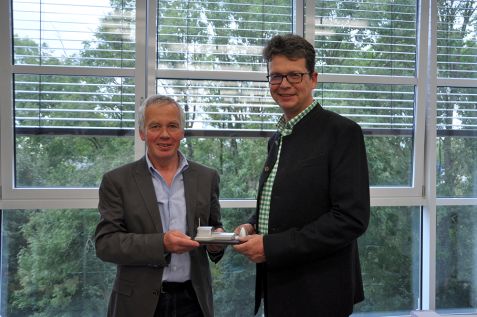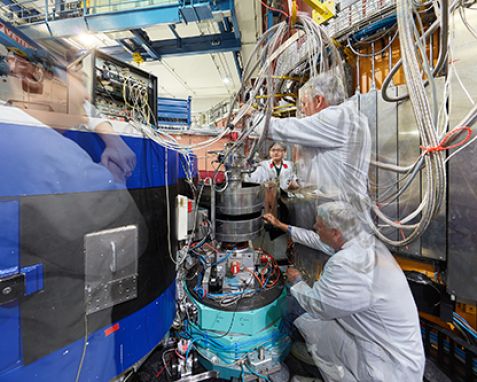MLZ is a cooperation between:
 > Technische Universität München
> Technische Universität München > Helmholtz-Zentrum Hereon
> Helmholtz-Zentrum Hereon
 > Forschungszentrum Jülich
> Forschungszentrum Jülich
MLZ is a member of:
 > LENS
> LENS > ERF-AISBL
> ERF-AISBL
MLZ on social media:

MLZ (eng)
Lichtenbergstr.1
85748 Garching
18.10.19
Honour for the “Father of PUMA”

Prof. Dr. Peter Müller-Buschbaum (r.) symbolically presents Prof. Dr. Götz Eckold an aluminium modell of the FRM II. © FRM II / TUM
Prof. Dr. Götz Eckold has now been awarded the Prize for Instrumentation and Scientific Use of the MLZ for his many years of extraordinary commitment. The MLZ honours his great commitment to instrumentation and in particular the instrument PUMA (the three axes spectrometer that in German stands for Polarisationsanalyse Und Multi-Analysator).
Götz Eckold already had the blueprint for the new measuring instrument in his pocket before the start of FRM II’s construction. At the first planning meeting for the FRM II instruments in 1995, the man from Göttingen already knew exactly what he wanted: a three axes spectrometer that measured with thermal neutrons and opened up new measuring possibilities beyond the then widely used design. A very similar idea came from the group of Prof. Dr. Winfried Petry, at that time newly appointed Scientific Director of the FRM II project. “We then quickly merged our plans,” says Prof. Winfried Petry, who has been retired for one and a half years. The result was PUMA, which was realised after a short construction period thanks to funding from the Federal Ministry of Education and Research (BMBF) to the University of Göttingen and has been available to German and international researchers since the start of routine operation of the FRM II.

The three axes spectrometer PUMA with instrument scientist and technician view from an artistic perspective. © Bernhard Ludewig
Scientific Director Prof. Dr. Peter Müller-Buschbaum symbolically presented Professor Götz Eckold from Göttingen with a miniature model of the research neutron source made of aluminium at the annual meeting of the MLZ university group leaders on 26 September. In his laudatory speech, Prof. Müller-Buschbaum emphasised: “Götz Eckold’s special commitment to continuously developing the instrument and the associated technologies has led to almost 20 years of funding for PUMA from the BMBF until 2018, which certainly represents a record in the acquisition of third-party funding. Götz Eckold can also be justifiably called the intellectual “father of PUMA”. But the heart of Götz Eckold was not only beating for PUMA. In his own workshop in Göttingen, Götz Eckold also had the focusing monochromators and copper monochromator crystals developed for PUMA produced for other measuring instruments at the FRM II.
Since its commissioning in 2005 as one of the first instruments at the research neutron source, the PUMA instrument has developed excellently. Since then, numerous publications have been based on the instrument and its scientists, mostly with a high impact factor. International groups use PUMA to study a wide variety of samples, such as superconductors, that lead to spectacular results published in very renowned scientific journals such as Nature or Science.
Götz Eckold has been professor at the Institute of Physical Chemistry at the Georg-August-Universität Göttingen since 1996. From 1993 to 1999, he was an active, elected member of the Committee for Research with Neutrons in Germany (KFN) and was Vice-Chairman of the KFN from 2005 to 2008 and its Chairman from 2008 to 2011. For the FRM II, Götz Eckold was chairman of the instrumentation advisory committee and member of the scientific advisory board / steering committee from 2001 to 2006. Since October 1, 2019, he has been officially retired.
MLZ is a cooperation between:
 > Technische Universität München
> Technische Universität München > Helmholtz-Zentrum Hereon
> Helmholtz-Zentrum Hereon
 > Forschungszentrum Jülich
> Forschungszentrum Jülich
MLZ is a member of:
 > LENS
> LENS > ERF-AISBL
> ERF-AISBL
MLZ on social media:


